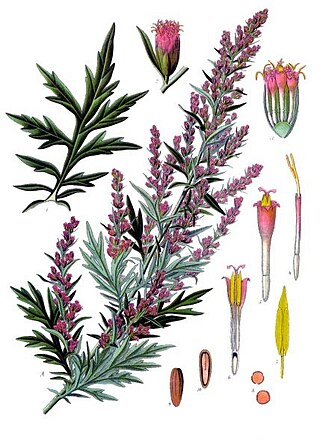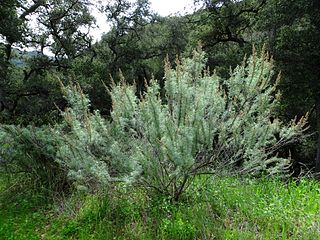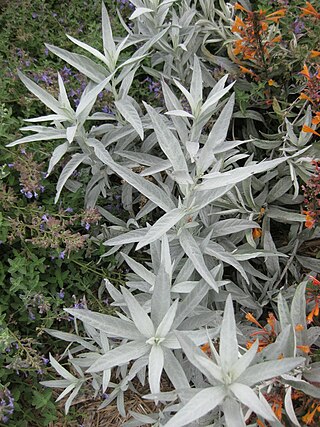
Tarragon, also known as estragon, is a species of perennial herb in the family Asteraceae. It is widespread in the wild across much of Eurasia and North America and is cultivated for culinary and medicinal purposes.

Artemisia is a large, diverse genus of plants belonging to the daisy family Asteraceae, with almost 500 species. Common names for various species in the genus include mugwort, wormwood, and sagebrush.

Artemisia vulgaris, the common mugwort, is a species of flowering plant in the daisy family Asteraceae. It is one of several species in the genus Artemisia commonly known as mugwort, although Artemisia vulgaris is the species most often called mugwort. It is also occasionally known as riverside wormwood, felon herb, chrysanthemum weed, wild wormwood, old Uncle Henry, sailor's tobacco, naughty man, old man, or St. John's plant. Mugworts have been used medicinally and as culinary herbs.

Artemisia II of Caria was a naval strategist, commander and the sister and the successor of Mausolus, ruler of Caria. Mausolus was a satrap of the Achaemenid Empire, yet enjoyed the status of king or dynast of the Hecatomnid dynasty. After the death of her brother/husband, Artemisia reigned for two years, from 353 to 351 BCE. Her ascension to the throne prompted a revolt in some of the island and coastal cities under her command due to their objection to a female ruler. Her administration was conducted on the same principles as that of her husband; in particular, she supported the oligarchical party on the island of Rhodes.

Artemisia absinthium, otherwise known as common wormwood, is a species of Artemisia native to North Africa and temperate regions of Eurasia, and widely naturalized in Canada and the northern United States. It is grown as an ornamental plant and is used as an ingredient in the spirit absinthe and some other alcoholic beverages.

Arenaria is a genus of flowering plants, within the family Caryophyllaceae.

Wormwood is a star or angel which appears in the Book of Revelation.

Deosai National Park is a high-altitude alpine plain and national park located between the Skardu District and Astore District in Gilgit-Baltistan, Pakistan.

Mugwort is a common name for several species of aromatic flowering plants in the genus Artemisia. In Europe, mugwort most often refers to the species Artemisia vulgaris, or common mugwort. In East Asia the species Artemisia argyi is often called "Chinese mugwort" in the context of traditional Chinese medicine, Ngai Chou in Cantonese or àicǎo (艾草) for the whole plant in Mandarin, and àiyè (艾叶) for the leaf, which is used specifically in the practice of moxibustion. Artemisia princeps is a mugwort known in Korea as ssuk (쑥) and in Japan as yomogi (ヨモギ). While other species are sometimes referred to by more specific common names, they may be called simply "mugwort" in many contexts.

Artemisia californica, also known as California sagebrush, is a species of western North American shrub in the sunflower family.

Lomatium roseanum, adobe parsley, also known as adobe lomatium and rose-flowered desert-parsley, is a very rare plant of the Western U.S., known only from northwestern Nevada and southeastern Oregon, and which may also occur in northeastern California. The largest populations occur on the Sheldon National Wildlife Refuge. It is a member of the celery family, the Umbelliferae, and has yellow flowers.

Artemisia pycnocephala is a North American species of sagebrush in the sunflower family, known by the common names beach wormwood, sandhill sage, and coastal sagewort.

Artemisia campestris is a common and widespread species of plants in the sunflower family, Asteraceae. It is native to a wide region of Eurasia and North America. Common names include field wormwood, beach wormwood, northern wormwood, Breckland wormwood, boreal wormwood, Canadian wormwood, field sagewort and field mugwort.

Artemisia ludoviciana is a North American species of flowering plant in the daisy family Asteraceae, known by several common names, including silver wormwood, western mugwort, Louisiana wormwood, white sagebrush, lobed cud-weed, prairie sage, and gray sagewort.

Castilleja cinerea is a species of Indian paintbrush known by the common name ashgray Indian paintbrush. It is endemic to San Bernardino County, California, where it is known only from the San Bernardino Mountains. There are about 20 occurrences known.
Cassida sareptana is a species of brownish beetle in the leaf beetle family, found in Kazakhstan, Mongolia, Russia and Ukraine. They can be found in Near East as well. The species feeds on plants from the family Asteraceae, including tarragon and Artemisia arenaria.
Aliciella penstemonoides is a species of flowering plant in the phlox family known by the common names Black Canyon gilia and beardtongue gilia. It is endemic to Colorado in the United States.
A. norvegica may refer to:















